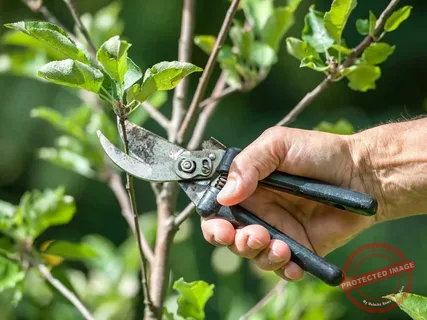Pittosporum is a versatile and evergreen shrub native to Asia, Africa, and the Pacific regions. Known for its attractive foliage and fragrant flowers, this plant has become a favorite for gardeners looking to enhance their landscapes with dense hedges, privacy screens, or decorative shrubs. Pittosporum species are highly adaptable, making them ideal for a variety of growing conditions, whether you’re planting them in your garden or using them as ornamental features in containers.
This low-maintenance shrub is popular not only for its aesthetic appeal but also for its drought tolerance and ability to thrive in coastal regions where salt spray can be an issue. With proper care, Pittosporum can grow into a well-formed hedge or a standalone feature in your garden. Whether you’re a beginner or an experienced gardener, Pittosporum offers an easy-care option that can complement many garden designs, from formal to contemporary styles.
In this guide, we will cover everything you need to know about growing and caring for Pittosporum, from selecting the right variety to understanding its basic care requirements. You will also learn how to prune and maintain the plant, ensure it thrives in various conditions, and troubleshoot common issues such as pests and diseases. By the end, you will be equipped with the knowledge to cultivate a healthy, lush Pittosporum shrub that will add beauty and structure to your outdoor space.
Selecting the Right Pittosporum Variety
Pittosporum comes in various species and cultivars, each with its unique characteristics in terms of size, leaf shape, color, and growth habits. Choosing the right variety for your garden is crucial, as it will affect how well the plant fits into your landscape and how much maintenance it will require.
1. Common Varieties: One of the most popular species is Pittosporum tenuifolium, also known as “Kohuhu,” native to New Zealand. It features wavy, dark green leaves with a silver underside and can grow up to 30 feet tall if left unpruned. This variety is often used as a hedge or screening plant due to its dense foliage. Another well-loved variety is Pittosporum tobira, also known as the “Japanese Mock Orange.” This variety has glossy, leathery leaves and is more compact, reaching up to 10 feet in height, with fragrant white flowers that bloom in spring.
2. Dwarf Varieties: For gardeners with smaller spaces or those looking for ornamental plants to place in containers, dwarf varieties like Pittosporum tenuifolium ‘Golf Ball’ or Pittosporum tobira ‘Nanum’ are perfect choices. These compact varieties grow into neat, rounded shapes, making them ideal for borders or as a statement piece in a patio garden. ‘Golf Ball’ typically grows 3 to 4 feet tall and wide, while ‘Nanum’ remains even more compact, making it suitable for tight spaces.
3. Leaf Colors and Textures: One of the attractions of Pittosporum is the variety of foliage colors. You can choose from green, variegated, or even silver-leaved varieties depending on your design preferences. Variegated Pittosporum, such as Pittosporum tenuifolium ‘Variegatum’, features green leaves edged with creamy white, offering a striking contrast in your garden. These types can brighten shady areas and add visual interest to a garden full of darker green plants.
4. Climate Considerations: Pittosporum thrives in USDA hardiness zones 8 to 11, though specific varieties may have slightly different temperature tolerances. Some varieties are more suited for coastal regions and can tolerate salty air, while others may perform better in more temperate inland environments. Consider your local climate when selecting the variety, ensuring it can handle both the winter low temperatures and summer heat typical of your region.
Planting Pittosporum
Proper planting is key to ensuring your Pittosporum establishes itself well and thrives in your garden. Whether you’re planting a hedge, a specimen shrub, or a container plant, paying attention to the planting process can make a big difference in its overall health.
1. Location and Soil Requirements: Pittosporum prefers a sunny location with well-draining soil, although it can tolerate partial shade. The plant does best in soils that are slightly acidic to neutral, with a pH range of 6.0 to 7.5. While it can handle a range of soil types, from sandy to loamy, ensuring the soil drains well is essential. Pittosporum is not tolerant of waterlogged soils, as this can lead to root rot. If your garden soil is heavy or clay-like, consider amending it with organic matter such as compost to improve drainage.
2. Planting Depth and Spacing: When planting Pittosporum, dig a hole that is twice as wide and just as deep as the plant’s root ball. Position the shrub so that the top of the root ball is level with the surrounding soil. Backfill the hole with soil, tamping it down lightly to remove any air pockets, and water thoroughly. When planting multiple Pittosporum shrubs for a hedge, space them 2 to 3 feet apart, depending on the variety and your desired level of density.
3. Mulching and Watering: After planting, apply a 2 to 3-inch layer of mulch around the base of the plant to help retain moisture and suppress weed growth. Keep the mulch away from the stem to avoid rot. Pittosporum requires regular watering, especially during the first few months as the plant establishes itself. Water deeply once a week, allowing the soil to dry out slightly between waterings. Once established, Pittosporum is relatively drought-tolerant, although it will appreciate occasional watering during prolonged dry periods.
4. Transplanting and Container Growing: If you’re growing Pittosporum in a container, ensure the pot has good drainage holes and use a high-quality potting mix. Containers will need more frequent watering than plants in the ground, so monitor the soil moisture closely. Pittosporum can be transplanted, but it’s best to do so in the spring or fall when the weather is cooler and less stressful for the plant. If transplanting an established shrub, be sure to dig a wide root ball and avoid disturbing the roots as much as possible.
Caring for Pittosporum
Pittosporum is a relatively low-maintenance plant, but it will thrive with proper care and attention. Providing the right amount of water, nutrients, and pruning will help ensure your Pittosporum grows into a healthy and attractive plant.
1. Watering Needs: Once established, Pittosporum is fairly drought-tolerant, but like most plants, it performs best with consistent moisture. During the growing season, water the plant regularly, ensuring the soil remains moist but not soggy. If you’re unsure when to water, check the top few inches of soil—if it feels dry, it’s time to water. Reduce watering during the winter months when the plant is not actively growing, but don’t let the soil dry out completely.
2. Fertilizing Pittosporum: Pittosporum benefits from light fertilization, particularly in the spring and early summer when new growth begins. Use a balanced, slow-release fertilizer with equal parts nitrogen, phosphorus, and potassium, or apply a specialized shrub fertilizer. Be careful not to over-fertilize, as this can lead to excessive leaf growth at the expense of flowers. A light application of compost around the base of the plant can also provide nutrients and improve soil structure.
3. Pruning and Shaping: Pittosporum responds well to pruning, making it an excellent choice for formal hedges or topiary. Regular pruning helps maintain the plant’s shape and encourages denser growth. The best time to prune is in late winter or early spring before new growth begins. For hedges, trim the sides and top to maintain a uniform shape. If you’re growing a standalone shrub, prune lightly to remove any dead or crossing branches, and shape the plant to your desired form. Dwarf varieties typically require less pruning, but they can still benefit from occasional shaping to keep them neat and compact.
4. Pests and Diseases: Pittosporum is generally pest-resistant, but it can occasionally be affected by aphids, scale insects, or spider mites. These pests can be controlled with insecticidal soap or horticultural oil. In terms of diseases, Pittosporum is susceptible to root rot if planted in poorly draining soil. To prevent this, ensure proper soil drainage and avoid overwatering. Leaf spot and powdery mildew can also occur in humid conditions, but these can be managed by improving air circulation around the plant and using appropriate fungicides if necessary.
Propagating Pittosporum
If you’re interested in expanding your Pittosporum collection, propagation is a simple and cost-effective way to grow new plants. Pittosporum can be propagated by seed, cuttings, or layering, each with its advantages.
1. Propagating by Seed: Pittosporum seeds can be collected from mature plants in the fall when the seed pods ripen. After collecting the seeds, clean them thoroughly and sow them in trays filled with a well-draining seed-starting mix. Keep the soil moist and place the trays in a warm, sunny location. Germination can take several weeks, so be patient. Once the seedlings have developed a few sets of true leaves, they can be transplanted into individual pots or directly into the garden.
2. Propagating by Cuttings:
One of the most reliable methods for propagating Pittosporum is through semi-hardwood cuttings. In late summer or early fall, take cuttings about 4 to 6 inches long from healthy, non-flowering stems. Remove the lower leaves, and dip the cut end into rooting hormone to encourage root development. Plant the cutting in a well-draining potting mix, and water it thoroughly. Place the pot in a warm, sheltered location with indirect light. Keep the soil moist but not waterlogged. Within a few weeks to a couple of months, roots should form, and the new plant will be ready for transplanting into the garden or a larger container.
3. Propagating by Layering:
Layering is another effective way to propagate Pittosporum, especially for those looking for a more hands-off approach. In spring or early summer, select a low, flexible branch from the parent plant and bend it toward the ground. Make a small incision in the stem where it touches the soil, then bury that section in the ground, leaving the tip of the branch exposed. Secure the buried section with a stone or U-shaped wire to keep it in place. Over time, roots will develop from the buried part of the stem, and the new plant can be separated from the parent and transplanted elsewhere in the garden.
Common Pittosporum Problems and How to Address Them
While Pittosporum is generally hardy and easy to care for, it can occasionally face issues related to pests, diseases, or environmental stressors. Being aware of these potential problems and how to handle them will ensure your plant remains healthy and vibrant.
1. Root Rot:
Root rot is a common problem when Pittosporum is planted in poorly draining soil or when it is overwatered. Symptoms include yellowing leaves, stunted growth, and a general decline in the plant’s health. To prevent root rot, always plant Pittosporum in well-draining soil and avoid overwatering. If you suspect root rot, carefully dig up the plant and trim away any affected roots. Replant in fresh, well-draining soil and reduce watering.
2. Leaf Spot:
Leaf spot can cause unsightly brown or black spots on the leaves of your Pittosporum, often due to fungal infections. This issue is more prevalent in humid conditions where water sits on the leaves for extended periods. To prevent leaf spot, water the plant at the base to avoid wetting the foliage, and ensure there’s adequate air circulation around the plant. If leaf spot occurs, remove the affected leaves and apply a fungicide to control the spread.
3. Aphids and Scale Insects:
Aphids and scale insects can occasionally attack Pittosporum, feeding on the sap and weakening the plant. Aphids are tiny, soft-bodied insects, while scale insects are small and often appear as bumps on stems and leaves. These pests can cause leaf curling, yellowing, and stunted growth. To manage them, spray the plant with insecticidal soap or horticultural oil. For smaller infestations, you can also wipe them off with a damp cloth.
4. Spider Mites:
Spider mites are another common pest, especially in dry, dusty conditions. These tiny pests suck sap from the leaves, causing stippling, bronzing, or webbing on the foliage. To prevent spider mites, keep your Pittosporum well-watered and mist the foliage regularly to increase humidity. If an infestation occurs, use insecticidal soap or neem oil to control the population.
Pruning and Shaping for Maximum Growth
Pruning Pittosporum is not only about maintaining its appearance but also encouraging healthy growth. Proper pruning ensures that air circulates through the plant, which reduces the risk of diseases and promotes denser foliage, making your plant more vibrant.
1. When to Prune:
The best time to prune Pittosporum is in late winter or early spring before new growth starts. This timing allows the plant to recover quickly and encourages robust growth during the growing season. However, light pruning can be done throughout the year to remove dead or damaged branches.
2. Techniques for Pruning Hedges:
If you’re growing Pittosporum as a hedge, regular pruning is necessary to maintain its shape and density. Start by trimming the sides and top of the hedge, keeping the top slightly narrower than the base to allow light to reach the lower branches. This technique ensures even growth and prevents the hedge from becoming thin at the bottom. Prune at least twice a year, more often if you want a tighter, more formal look.
3. Pruning Standalone Plants:
For standalone Pittosporum plants, pruning is less intensive. Focus on removing any dead, diseased, or crossing branches to improve airflow and encourage a natural shape. If you want to maintain a specific size or shape, trim back the branches lightly after the plant has finished flowering. Dwarf varieties may need little to no pruning, but occasional shaping will help keep them compact.
4. Tools for Pruning:
When pruning Pittosporum, use sharp, clean pruning shears or loppers to make precise cuts. For larger branches, a pruning saw may be necessary. Always disinfect your tools before and after pruning to prevent the spread of diseases. Cut just above a leaf node or bud to encourage new growth in the desired direction.
Caring for Pittosporum in Different Climates
Pittosporum is a versatile plant that can adapt to various climates, but it performs best when its specific needs are met. Understanding how to care for Pittosporum in different conditions will help ensure it thrives no matter where you live.
1. Pittosporum in Hot Climates:
In warmer regions, such as USDA zones 9 to 11, Pittosporum thrives under full sun but may require extra watering during prolonged heatwaves. Mulching around the base of the plant can help retain soil moisture and keep the roots cool. In areas with intense summer heat, consider providing some afternoon shade to prevent leaf scorching.
2. Pittosporum in Cooler Climates:
In cooler climates, Pittosporum can tolerate light frost, but temperatures below 20°F (-6°C) may damage the plant. For varieties growing in USDA zones 8 and lower, it’s important to plant them in a sheltered location, such as near a wall or fence, to protect them from harsh winds. You can also cover the plant with frost cloth during particularly cold nights. Container-grown Pittosporum can be moved indoors or into a greenhouse during cold spells.
3. Coastal Regions:
Pittosporum is an excellent choice for coastal gardens due to its high tolerance for salt spray and windy conditions. If you live near the ocean, plant Pittosporum where it can serve as a windbreak or salt-tolerant hedge. The key is to ensure well-drained soil, as coastal areas can often be prone to heavy rains, which might lead to waterlogged soil.
4. Managing Drought:
Once established, Pittosporum is quite drought-tolerant, making it an excellent choice for water-wise gardens in dry regions. In drought-prone areas, deep watering once every two weeks is typically sufficient. Adding a thick layer of mulch around the base of the plant will help conserve moisture and reduce the need for frequent watering.
Conclusion
Growing and caring for Pittosporum can be a rewarding experience, whether you’re looking to add structure to your landscape, create a lush privacy hedge, or enhance your garden with ornamental plants. This versatile shrub thrives in a variety of climates and can be adapted to different garden styles, making it a favorite among gardeners of all skill levels. By selecting the right variety, planting it in well-draining soil, and providing proper care through watering, pruning, and pest control, your Pittosporum will flourish for years to come.
With its low-maintenance nature, Pittosporum is a perfect choice for those looking to add a hardy, yet beautiful element to their garden. Whether you’re growing a formal hedge or a standalone specimen, this plant will reward you with attractive foliage, fragrant flowers, and a year-round evergreen presence. Follow the guidelines in this guide, and you’ll have all the tools you need to grow a healthy, thriving Pittosporum that will be the envy of your neighborhood.



